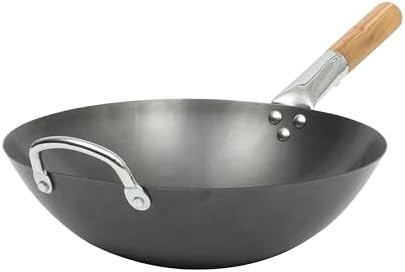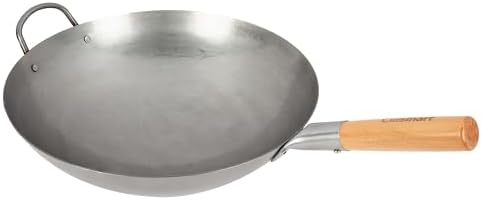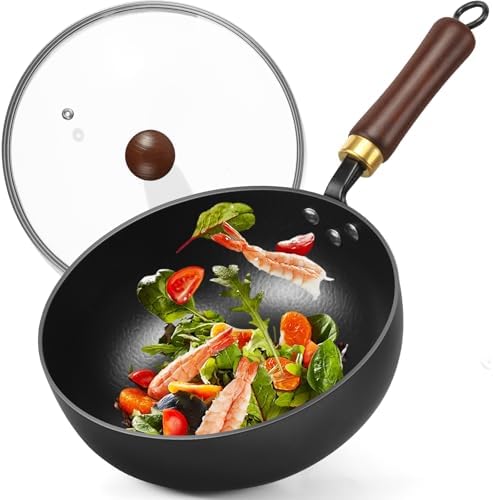Learning Carbon Steel Woks
Carbon steel woks are a cook’s best friend for most people, much lauded for their performance in spreading heat and storing it. Made primarily of iron and a small amount of carbon. The woks offer a subtle combination of hardness and flexibility that no other material, such as stainless steel or cast iron, can provide. Their light weight makes them easy to handle with authority, suited for stir-frying, searing, and even steaming foods.
One of the key advantages of using a carbon steel wok is that it is non-stick, but it achieves this over the years by seasoning. When oil is heated and applied. A polymerization process creates a natural coating, which prevents food from sticking to the surface, reducing the use of artificial non-stick coatings. This feature results in healthier cooking, as less oil is used, without losing taste to health considerations.
Also, carbon steel woks heat up rapidly, allowing for quick cooking. Which is necessary for techniques like stir-frying where uniform and instant heat distribution is extremely crucial. Compared to stainless steel, which has fairly low thermal conductivity. The very good retention of heat by carbon steel results in food cooked in such woks being uniformly cooked and retaining its nutrients and flavor better.
The right care and maintenance of a carbon steel wok are critical in maintaining its functionality and longevity. Re-seasoning and cleaning schedules have to be adhered to in order to prevent rusting and maintaining its non-stick status. Discovering how to take proper care and maintenance of your carbon steel wok is not just a hygiene factor. It is an integral part of sustaining the functional viability of the wok and enhancing your culinary experience. In the following sections, we are going to discuss the right and wrong ways of cleaning carbon steel woks.
Right Ways of Cleaning a Carbon Steel Wok
The correct cleaning of a carbon steel wok is vital to make it durable and effective for cooking. After cooking, rinsing the wok with hot water should immediately be done to remove food particles and grease adhering to its surface. This initial rinsing must be immediately performed while the wok is still hot but not hot to the point of burning. As this will make it easy to clean without damaging the surface.
In order to clean the wok properly, use a mild scrubber, like a soft sponge or a non-stick cookware brush. Avoid steel wool or abrasive cleaners, as these tend to scratch the seasoned coating on carbon steel. The seasoned coating is essential because it not only creates a non-stick surface but also prevents rust on the wok. If there is still stuck food remaining after cleaning, apply a small amount of mild dish soap in moderation because excessive soap might wash away the seasoning.
Once the surface is properly cleaned, drying the wok quickly is essential to prevent rust formation. This can be done by heating it on low heat for a few minutes, expelling any moisture. Next, add a few drops of cooking oil and wipe it all over the surface with a paper towel. Not only does this prevent rust, but it also reinstates the required seasoning layer.
For normal deep cleaning, there are some methods that can be employed without damaging your carbon steel wok. In case of the occurrence of food residue accumulation or discoloration, you can undertake a more thorough cleaning through a mixture of water and baking soda. However, it is important to follow this up with the process of oiling later to restore and maintain the seasoning. With the employment of these correct methods of cleaning, your carbon steel wok will be active in your culinary undertakings.
Wrong Methods to Avoid When Cleaning a Carbon Steel Wok
Cleaning a carbon steel wok requires proper care in order to maintain its unique properties, but many people unknowingly apply methods that might be damaging. One of the wrong methods is using aggressive detergents and chemical cleansers. In contrast to common cookware, which can withstand powerful cleaning products, carbon steel is extremely sensitive. Harsh chemicals have the ability to strip off the wok’s natural seasoning, a polymerized oil layer that builds up over time and is responsible for the non-stick characteristic. As the seasoning layer wears thin, so is the possibility of the food sticking, thereby making the wok less functional.
Soaking the wok in water is another frequent error. While it might be an efficient way of loosening such stubborn food residue, soaking will actually lead to the formation of rust. Carbon steel will respond to extended contact with moisture and lead to ugly corrosion that weakens the material. A gentle rinse after cooking and finishing with a soft sponge or cloth would be more appropriate to avoid submersion of water.
Moreover, the use of metal utensils also has the inadvertent effect of scratching the surface of the wok. With sharp or abrasive-edged implements, scratch marks on the surface can damage the seasoning layer, rendering the wok more susceptible to rust and food sticking. Wooden or silicone utensils are more suitable to use on the surface.
Ignoring these cleaning mistakes can yield bad long-term effects on the performance and lifespan of your carbon steel wok. Equipped with the proper knowledge and a more delicate approach to cleaning, you can keep your wok well-seasoned, prevent rust, and enjoy optimal performance for a long time ahead.
Caring for Your Carbon Steel Wok for Extended Use
It is necessary to take care of your carbon steel wok to make it last longer and be used in the kitchen. Other than the first-time cleaning, having a regular maintenance routine keeps your wok in its optimum condition so you can keep serving scrumptious meals for many more years. Re-seasoning the wok is just one key part of this routine involving putting a thin layer of oil on the cooking surface and heating it to create a non-stick coating. Depending on usage, this step may be required every few months or as needed, especially when food is beginning to stick or when the surface is becoming cloudy.
Storage is also an important element of maintaining your carbon steel wok in excellent shape. You should keep the wok dry to prevent rust. You can put a paper towel or cloth inside the wok to absorb any excess moisture as well as protect the surface from further harm. Keeping your wok on top of other cookware, however, should involve padding between them to prevent being scratched and damaged.
Beyond re-seasoning and storage, you also need to take care of any minor repairs that your wok will require in the process. Minor scrapes, discoloration, or rust spots need to be dealt with right away. Minor rusts can typically be scrubbed off using a gentle abrasive, either a sponge or a scrubber, and then have the affected area re-seasoned. When the deterioration or warping is severe, you may need professional restoration to ensure your wok performs and appears as well as it did originally.
Lastly, knowing when your wok requires more than cleaning requires checking the performance of your wok while cooking and the condition of its surface. Through keen observation and proper maintenance, you can maintain your carbon steel wok in optimal condition and be able to reap its culinary benefits for years to come.












